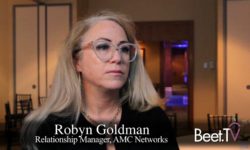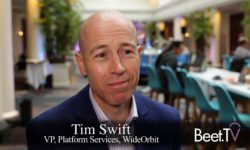SAN FRANCISCO – As are their national counterparts, local television broadcasters are trying to come to grips with the pace of digital-linear convergence. But if they collaborate with one another, the technological tide is flowing in their direction.
So says Bruce Roberts, President of WideOrbit, in this interview with Beet.TV at the platform provider’s WideOrbit Connect conference. In fact, the annual gathering is all about collaboration.
“We need to work more closely with all our clients as their business changes and it changes at an incredible pace and equally as important they need to collaborate with each other,” says Roberts. “Hopefully collectively we can start providing solutions that help them resolve the issues that they’re dealing with today and more importantly about what they’ll deal with in the future.
He describes the opportunities posed by technology and data as enormous. “They really are. There’s a lot of good technology coming forward that’s going to allow them to increase their existing revenue streams as well as open up new opportunities of other revenue streams.”
A prime example is the newly approved ATSC 3.0 Internet-protocol-based standard for local broadcasters. The “direct-to-consumer type of delivery” will enable more precise audience targeting and reach given its potential among people who don’t pay for a cable or satellite package.
Roberts believes that more dollars will flow into local TV as automation and programmatic transactions gain a bigger foothold. “Much more so than what was going out of the medium, going over to network or digital,” he says.
WideOrbit’s Open Marketplace programmatic platform provides access to open-bid linear TV inventory for demand-side platforms. “They’re buying quality programming, quality inventory and they’re basically able to guarantee all of that through attribution. So it’s a great new opportunity in that area,” says Roberts.
On the private marketplace side, WideOrbit clients can white label Open Marketplace and, using Deal ID, enable advertisers to plug directly into those clients’ inventory.
Tribune Broadcasting recently launched an “always-open” TV ad sales operation in a technology partnership with WideOrbit. Among other attributes, a new rule-based auto-acceptance feature enables Tribune to accept complying offers for ad time around the clock.
While a tiny percentage of local TV inventory is now sold programmatically, Roberts sees that rising to perhaps 30% or 40% over the next five years. Along the way, the way inventory is transacted is likely to evolve.
“One of the things that may need to change, who knows if it will, is the currency that local broadcast deals in,” which is based on ratings points as opposed to impressions.
This video is part of a Beet.TV series on advanced TV produced at the WideOrbit Connect conference. WideOrbit is the sponsor of this series. Please find more videos here.












































